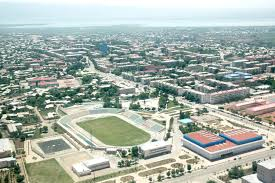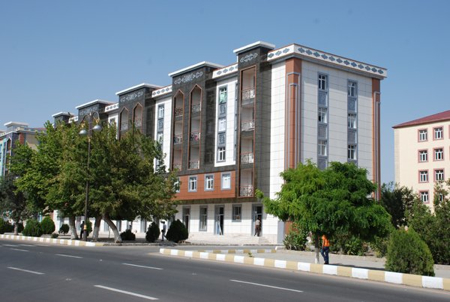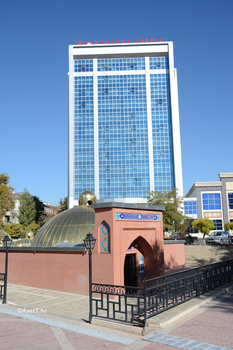City of Nakhchivan
Total territory [sq. km] |
191,57 |
Total number of population [th.people] |
97,2 |
Settlements |
1 |
Villages |
5 |
Municipalities |
4 |
Distance to Baku |
536 km |
Nakhchivan is the capital of the Nakhchivan Autonomous Republic and one of the most ancient cities of Azerbaijan. The conducted archeological researches of Nakhchivan revealed the patterns of material culture dating back to the 2nd-1st millenniums B.C. The culture of Nakhchivan close to the leading cultural centers of the Near East had a great impact on the life of the tribes settling there and the properties of city culture and class society appeared early in this area.
The first information about the Nakhchivan city is provided by the written works of historian Yosef Flavy (the 1st century B.C.) and Greek geographer Claudi Ptolemy in his work «Geography». The said work mentioned the name of Nakhchivan as «Naksuana». It should be noted that Naksuana is not the phonetic variant of Nakhchivan. As the Greek and roman languages did not have the hushing sounds ch, dj, s, zh Nakhchivan was called Naksuana.
The Medieval Arabian and Persian sources about the city (Bin Khordadbeh, Al-Biruni, Bakuvi and others) mentioned Nakhchivan as Nashave and Nagchuvan. Other sources (by Mohammed Nakhchivani, Hamdullah Gazvini, Ovliya Chelebi and others) used the name Nakhchivan which is proposed to be connected with the name of the Prophet Nuh and means the land of Nuh.
 Nakhchivan was part of Manna later of Midia states in the 9th-6th centuries B.C, and was subdued to the Ahameni Empire after the downfall of Midia in 550 B.C. After the collapse of the Ahameni empire Nakhchivan locating at the junction of the trade roads of Near and Middle East was part of Atropatena from the late 4th century B.C, till the early 1st century B.C. Nakhchivan that turned into an important art, trade and cultural centers of the Near and Middle east maintained trade relations with the countries of Asia Minor, Iran, with the cities of Georgia and the Black Sea ports.
Nakhchivan was part of Manna later of Midia states in the 9th-6th centuries B.C, and was subdued to the Ahameni Empire after the downfall of Midia in 550 B.C. After the collapse of the Ahameni empire Nakhchivan locating at the junction of the trade roads of Near and Middle East was part of Atropatena from the late 4th century B.C, till the early 1st century B.C. Nakhchivan that turned into an important art, trade and cultural centers of the Near and Middle east maintained trade relations with the countries of Asia Minor, Iran, with the cities of Georgia and the Black Sea ports.
During the war between Iran and Byzantium the Byzantium emperor Irakly occupied the city and ruined it in 625. Later Nakhchivan was restored and passed to the Arabians in 654. After the downfall of Arabian caliphate Nakhcivan was first annexed by the state of Sadjids and then by Salari state. It had been part of Ravvadi state from the late 10th till the mid 11th centuries. The city was annexed by the state of Saldjugs with the appearance of Saldjugs in Azerbaijan in 1054 and the downfall of the Ravvadi state. Following the split of Seldjugi state, Nakhchivan was annexed by the newly established state of Atabeys. Nakhchivan had been the capital of the said state from the late 1130s till 1175. Nakhchivan accounted for nearly 150-200 thousand people in the 12th century. It developed such spheres as weaving, jeweler’s art, pottery, carpentry and other types of art. During the first attack of Mongolians to Azerbaijan in 1221 Nakhchivan was subject to great destruction. Making use of the weakening of Atabeys state Djelaleddin Kharezmshah occupied Nakhchivan in 1225. Nakhchivan was annexed by the Elkhanids state in 1257. After the weakening of the state Nakhchivan was first annexed by the state of Chobanids and then by the state of Djelalis.
In 1386 Nakhchivan was first occupied by the khan of Gyzyl Orda Tokhtamysh and then by Amir Teymur.  Nakhchivan was part of Garagoyunlu state in 1412 and Aghgoyunlu in 1468. During the war between Aggoyunlus and Sefevis Sefevis won the battle in Sharur plain in 1501 and occupaied the city. Later Nakhchivan turned into a military ground for the wars between Sefevis and Osmanlys. Shah Abbas 1 subdued Nakhchivan in 1603 and turned the city into the military camp. The reforms conducted by Safevis resulted in the inclusion of Nakhchivan into Tebriz in the 16th century and into the Chukhursedd lands in the 17th century. In the 16th-17th centuries the leaders were appointed from the Kengerli tribe.
Nakhchivan was part of Garagoyunlu state in 1412 and Aghgoyunlu in 1468. During the war between Aggoyunlus and Sefevis Sefevis won the battle in Sharur plain in 1501 and occupaied the city. Later Nakhchivan turned into a military ground for the wars between Sefevis and Osmanlys. Shah Abbas 1 subdued Nakhchivan in 1603 and turned the city into the military camp. The reforms conducted by Safevis resulted in the inclusion of Nakhchivan into Tebriz in the 16th century and into the Chukhursedd lands in the 17th century. In the 16th-17th centuries the leaders were appointed from the Kengerli tribe.
After the overthrow of Sefevis, Nakhchivan was occupied by Nadir shah in the early 18th century. Following Nadir shah’s death the leader of Kengerli tribe Heydaroghlu was declared himself khan in 1747 and turned Nakhchivan into the capital of the khanate. Nakhchivan was occupied by the troops of Tsarist Russia on June 26, 1827. As the result of Russian-Iranian war Nakhchivan was annexed by Russia in accordance with the Turkmenchay contract of 1828. Nakhchivan settlement was established within Georgian-Imeretian province in 1841. The reforms conducted by Tsarist regime in 1870 led to the progress in the trade, industrial, health and cultural spheres of Nakhchivan. As the result of genocide conducted by Armenians against Azerbaijanis in 1905-1907, mass bloodshed was committed in Nakhchivan as well.  Later the event was repeated in 1918. The Araz Turkic Republic was established in Nakhchivan in 1918. The republic overthrew with the England’s occupation of Nakhchivan in the early 1919. The Soviet government was declared in Nakhchivan on July 28, 1920. At a referendum conducted in January, 1921, 90% of the population voted for the status of Autonomy under the Republic of Azerbaijan. The status of the Autonomous republic of Nakhchivan was founded by the Moscow contract of March 16, 1921 and Gars contract of October 13, 1921. The Nakhchivan Autonomous SSR was established on February 9, 1924 and Nakhchivan became the capital of it. At present Nakhchivan is the capital of the Autonomous Republic of Nakhchivan.
Later the event was repeated in 1918. The Araz Turkic Republic was established in Nakhchivan in 1918. The republic overthrew with the England’s occupation of Nakhchivan in the early 1919. The Soviet government was declared in Nakhchivan on July 28, 1920. At a referendum conducted in January, 1921, 90% of the population voted for the status of Autonomy under the Republic of Azerbaijan. The status of the Autonomous republic of Nakhchivan was founded by the Moscow contract of March 16, 1921 and Gars contract of October 13, 1921. The Nakhchivan Autonomous SSR was established on February 9, 1924 and Nakhchivan became the capital of it. At present Nakhchivan is the capital of the Autonomous Republic of Nakhchivan.
The administrative settlement Aliabad was included into the Nakhchivan city in accordance with the Law adopted by the President of the Republic of Azerbaijan of December 4, 2001 «On amendments to the administrative division of a number of regions of the Republic of Azerbaijan». The city accounted for one settlement (Aliabad) and covered an area of 35.5 km2. It has the population of 70 thousand people. Its climate is continental and the average temperature equals 3.8 C in January and 26.9 C in July with the average precipitation of 236 mm.
The development of Nakhchivan started in the times of Heydar Aliyev’s ruling over the country in the 1970s. Nakhchivan fell into a blockade as the result of Armenians’ intervention policy against Azerbaijan conducted in the late 1980s. Its gas line was cut in 1991 and the railwaty line was shutdown in 1992.
After gaining independence, the city was equipped with the Chess school, the Olympic Sport Complex, the swimming pool, the new five-storied building of the State University of Nakhchivan, Electronic Library, corpse for the faculty of Law and Social administration, the new building for the Customs Committee , the National Bank, the Rehabilitation Center for Invalids, the school after Heydar Aliyev and a number of other schools and new residential building for invalids. The tomb of Huseyn Djavid was erected in Nakhchivan, tens of administrative buildings underwent a profound repair, the park of Heydar Aliyev, the picnic places of Adjemi, dede Gordug were established and Heydar Aliyev’s bust and the monument of Heydar Aliyev in the yard of the school after Heydar Aliyev, the monuments of Babek, Koroghlu, Djalil Mamedguluzade, Adjami, Nakhchivani, the industrial and production complexes were created and the modern Grand hotel and other guest houses and restaurants were commissioned and a number of reconstruction works were carried out. All these works are closely connected with the name and political activity of the National Leader of the Azerbaijani people Heydar Aliyev.
